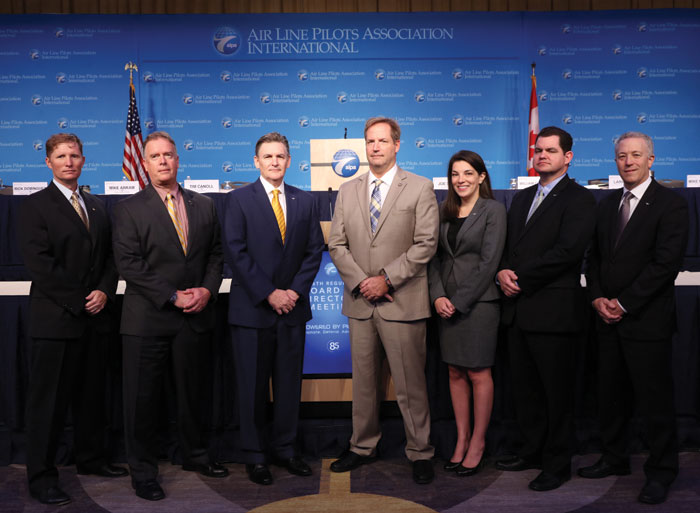ALPA@Work: ALPA’s EVPs—What They Do
The roles & responsibilities of ALPA’s executive vice presidents.
By John Perkinson, Senior Staff Writer

On Oct. 19, 2016, ALPA’s Board of Directors (BOD) elected the Association’s latest slate of executive vice presidents (EVPs): Group A: Capt. Andrew Massey (Delta), Capt. Russell Sklenka (FedEx Express), and F/O Mike Hamilton (United); Group B1: Capt. Michael McMackin (JetBlue); Group B2: F/O Karen Lacy (ExpressJet) [see “The Landing”]; Group B3: Capt. Matthew Chadwick (Air Wisconsin); and Group C: Capt. Dan Adamus (Jazz Aviation).
These seven pilot representatives will spend the next two years serving ALPA members and playing an important role in ALPA’s system of governance. But what distinguishes this office from those of ALPA’s other elected leaders?
The EVP position has been in existence since pilot representatives at the Association’s 1947 convention discussed its creation, and Clarence Sayen (Braniff) filled the position two years later. The original office was established to prepare him to serve as ALPA’s next president. Others would hold this office, including Capt. Sterling Camden (Eastern) and Capt. Kay McMurray (United).
However, ALPA’s BOD decided to reinvent the EVP position in 1974 “to ensure continuity of representation for the membership and to provide more effective coordination of board interests with organizational operations.” Serving as members of the Executive Committee, EVPs were tasked with representing BOD interests and advising ALPA’s president during the two-year interim between BOD meetings.
In time, the Executive Committee would morph into the Executive Council, and the role of the EVP would also evolve to meet the changing needs of ALPA and its members.
Article VI of ALPA’s Constitution & By-Laws notes that the Executive Council is composed of ALPA’s president, first vice president, vice president–administration/secretary, vice president–
finance/treasurer, and the EVPs and acts in consultation and cooperation with the president to further the objectives and policies of the BOD (predominantly ALPA’s local council status representatives) and Executive Board (chiefly the Association’s master executive council chairmen).
The Executive Council manages a large part of the union’s fiduciary responsibilities, serving as general trustees handling ALPA’s finances, business decisions, and approval of the Association’s budget. The Executive Council authorizes loans or guarantee notes, as needed, to fund approved programs. The group may interpret policy or initiate changes to policy or the Constitution & By-Laws. ALPA’s Executive Board or the BOD has the authority to establish policy, but only the BOD has final say on any proposed changes to ALPA’s Constitution & By-Laws (by a 2/3 majority vote).
A look at the Executive Council’s Oct. 15, 2016, meeting provides some insight into the kinds of issues EVPs can be asked to address. The Executive Council deliberated on nearly a dozen proposed resolutions. EVPs received briefings on the status of two Major Contingency Fund allocations to master executive councils and made decisions about the maintenance of the Association’s Operating Contingency Fund. They also reviewed current Major Contingency Fund expenditures and resolved several other pilot group concerns.
The Constitution & By-Laws’ Article XIV explains how EVPs are selected among ALPA’s member pilot groups. On the third day of a regular BOD meeting, master executive council members of the pilot group/groups represented form an election caucus. They make nominations, hear from each of the candidates, and elect a representative by roll-call, majority vote.
U.S. airlines with at least 4,000 active members in good standing, or with a projected annualized dues income of at least $10,000,000, come under the “Group A” EVP. U.S. airlines with fewer than 4,000 active members in good standing and with fewer than $10,000,000 in projected annualized dues income are divided into three subcategories: B1, B2, and B3. The “Group C” EVP represents pilots of ALPA’s Canadian member airlines.

